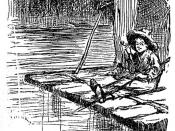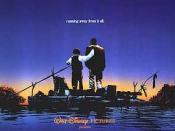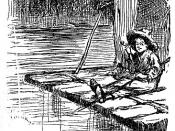Mark Twain uses slavery both as a metaphorical and as a literal image while Huck traverses through the "Sivilized" world, the Romantic world, and the Sacred world in "The Adventures of Huckleberry Finn". The "Sivilized" world, as Huck sees it, is mostly characterized by the strict rules and restrictions laid down by Miss Watson. Escaping through the window into the woods with Tom, his world is restricted specifically to what or how "the books" do certain things. Then, Huck stumbles into the Sacred world of Jim. Jim's world is characterized by the essential assets in life. While there are no social restrictions in his world, Jim is a slave; and therefore is literally in chains.
The "Sivilized" world is enslaved in the conformities and modern practices of the mid-nineteenth century. The general society of Huck Finn is one that is extremely similar to modern society today with regards to socially accepted standards and customs for the time.
Such standards and practices for the mid-1800's were fervid religious revivals, formal clothing, and constant hypocrisy on one another. Even though Twain exaggerates a bit, Miss Watson is a prime example of astute religious values and twisted sentiments.
"Then she told me all about the bad place, and I said I wished I was there.... She said it was wicked to say what I said; said she wouldn't say it for the world; she was going to live so as to go to the good place." Everything she does seems to be done for God and for the assurance of her own salvation with no regard for anyone else. Moral cowardice is also expressed in civilized society in Huck Finn. After Sherburn kills Boggs in the street, a "lynching mob" arrives at his porch to protest. He gives a long speech...


